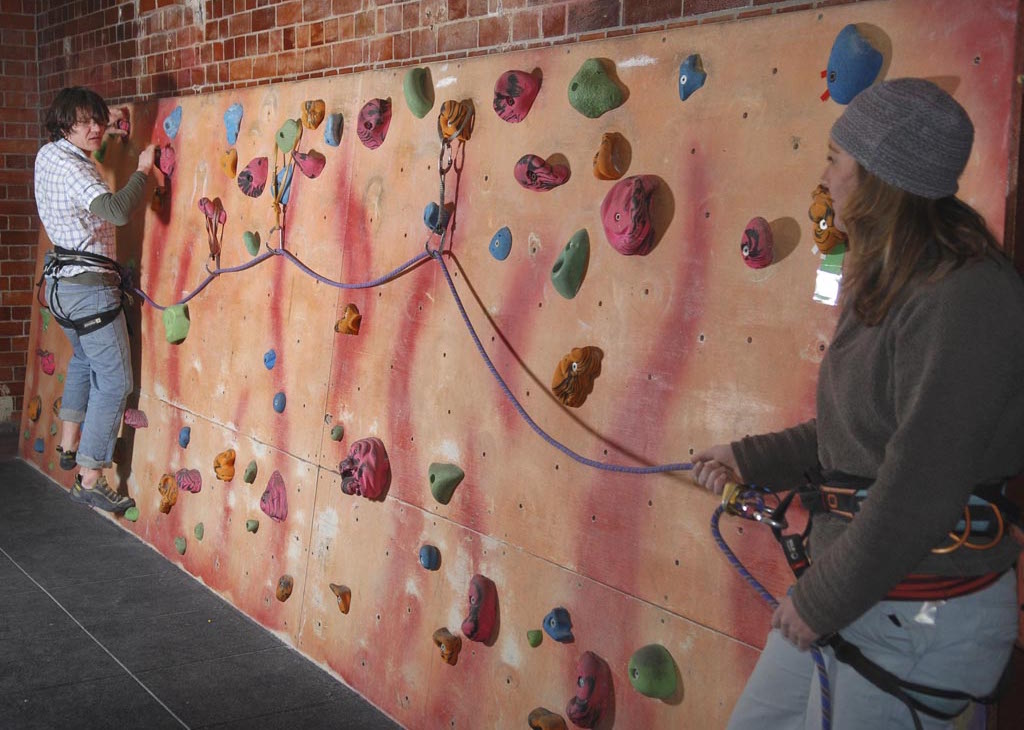Indoor rock climbing if done right and in a considered fashion should be extremely safe. However there are only a few things that you can learn off this webpage and the internet in general. This should be one of the times that you look for some professional instruction and guidance. Even if it just a several being taught how to put a harness on, tying in, belay and lower off correctly.
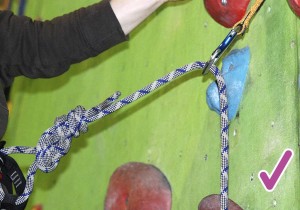
In fact most climbing wall insist that you can do the those four things before they let you loose in their facility. Some especially in major cities will check that you can do this with a mini test as well.
Harness
Harnesses need to be fitted probably and the buckles securely double based or locked off. The waist belt needs to be tight enough so it won’t pull down over your hip bone, a good rule of thumb is a fact hand can slide down the front but not a clenched fist.
Tying In with a figure of 8
The Figure of eight is the most common knot to tie in with whether we are indoor rock climbing or outdoor, because it is simple and reliable. Done well it is potentially the only knot you’ll ever need to tie in with.
Belaying and Lowering Off
In order to belay and lower someone off indoor rock climbing, you will need to be able to put a harness on and tie into the harness with a suitable knot like the figure of 8. As well as be able to thread the rope onto the belay device and karabiner properly. Finally you then need to be able to belay properly.
Safe and effective belaying is as important as the anchors and system at the top of the crag. Every year numerous people are injured both inside and out when they are dropped by their belayer. As a fundamental skill of climbing, belaying correctly should be of utmost importance, and requires concentration and communication by both belayer and climber.
Trying to multi-task when climbing should be avoided, eating your sandwiches, drinking a ask of coffee and even having a conversation can take your mind off the job in hand. Belaying properly requires both hands.
Belaying a bottom rope
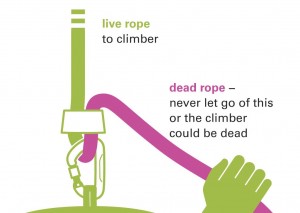
In order to belay properly you will need some coaching from an experienced climber. For the first few times climbing have someone tail the rope until you are ready to do it alone. Many climbers introducing friends to climbing have been dropped at both indoor walls and crags, whilst the novice remains safe it is when the novice belays the experience climber that accidents have more frequently happened.
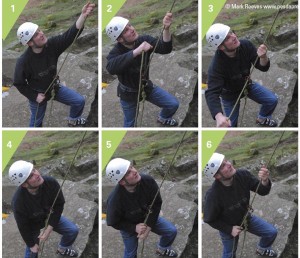
The most important thing is to never let go of the ‘dead rope’, whilst still keeping the rope snug as the climber ascends. This is achieve by the pattern in the photo sequence above.
- Prepare to take in the rope.
- Take in the rope.
- Lock the rope off.
- Move both hands to the dead rope.
- Swap the bottom hand to starting position below the belay plate.
- Prepare to take in the rope. Repeat the process until climber is ready to come down.
Eventually you will shorten this to:
- Take in
- Lock off
- Hand swap
- Back to the beginning
In the US they use the acronym, as they do the hand swap slightly differently to the UK.
- Pull
- Lock
- Under
- Slide
Caution – Always back up novice belayers and serious consider getting professional tuition to ensure your safety when learning this skill.
At times the climber may climb faster than a belayer can take the rope in, resulting in a lot of slack, if the climber falls there will be a considerable drop before the rope and gear is shock loaded. If you are climbing, slow down when you notice too much slack, if you belaying, ask the climber to pause whilst you catch up.
When the climber reaches the top you need a simple proceedure, talking to each other, making the rope tight before lowering the climber down. Repeating the same proceedure time and again reinforces the trust be- tween climber and belayer and reduces the likelyhood of an accidental drop as the climber weighs the rope.
Lower-off proceedure
1. The climber gets to the top and calls to belayer, “TAKE IN” the climber should look down to see if the belayer is taking in and if possible make eye contact to con rm the belayer has heard.
2. The belayer takes in rope and looks to see if it is tight on the climber. As the belayer feels the rope go tight they shout, “IS THAT YOU?”
3. The climber feels the rope go tight and looks to ensure the belayer has locked off, then keeping a hand on the rope going down to the belayer as a back up, lowers their weight onto the rope slowly, when you have commit- ted your weight to the rope and are happy that you are being held, shout “THAT’S ME”.
4. The belayer pauses, shouts “OK” and then starts to lower the climber in a slow and controlled fashion.
Bouldering
Indoor boulder also has some risk attached to it, in particular you are much more likely to fall. As such whilst the floor is well padded the risk is that you fall onto something or more likely, someone.
Being aware of who is around you when you are climbing is one side of the risk management coin. The other side is when you are not climbing you need to be aware of who is above you. Also not just walking round a corner but giving it a wide birth as someone can be high off the ground on of sight when you go round the corner.
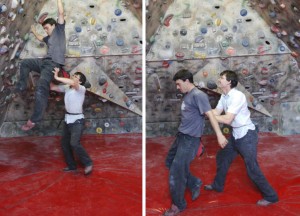
Managing yourself and your children is key, as landing on and being landed upon are extreme painful and have resulted in some horrible injuries. Remember the bouldering wall isn’t a play ground. As an 80kg adult falling from 8ft is not something you want on your or your child’s head.
See the section of bouldering safety for tips on spotting climbers. Indoors the spotter is as much trying to keep the landing zone clear of other wall users as a spotter.
